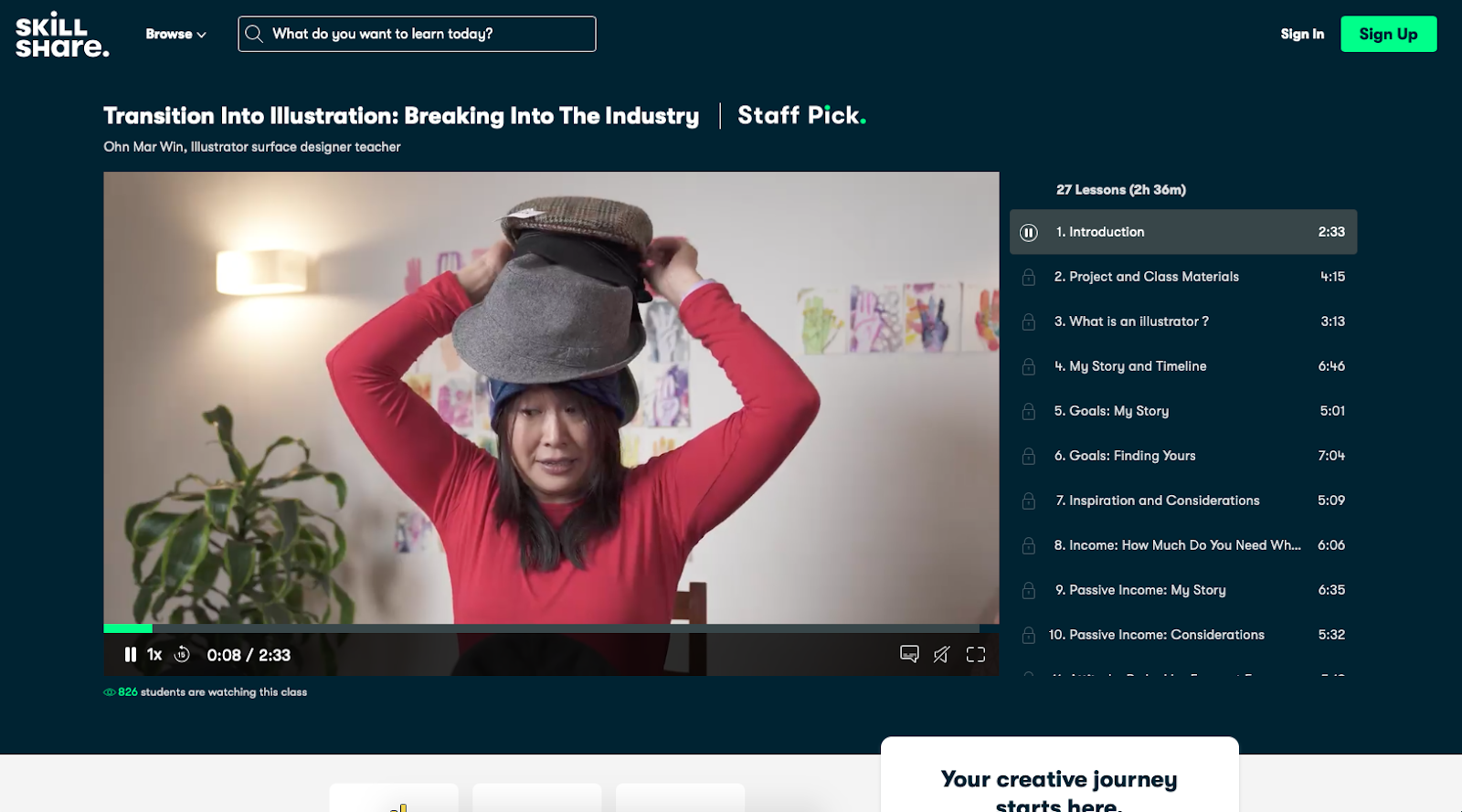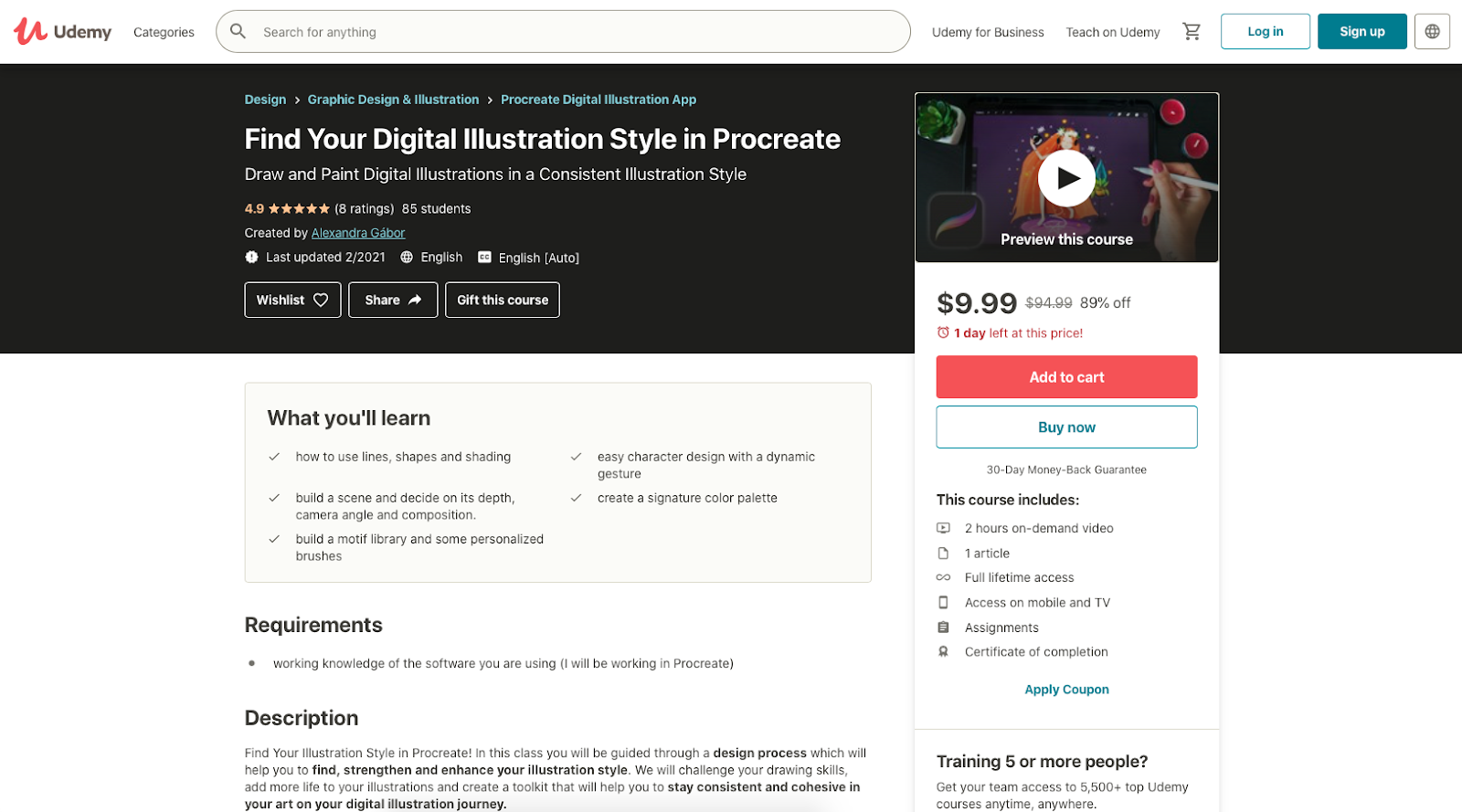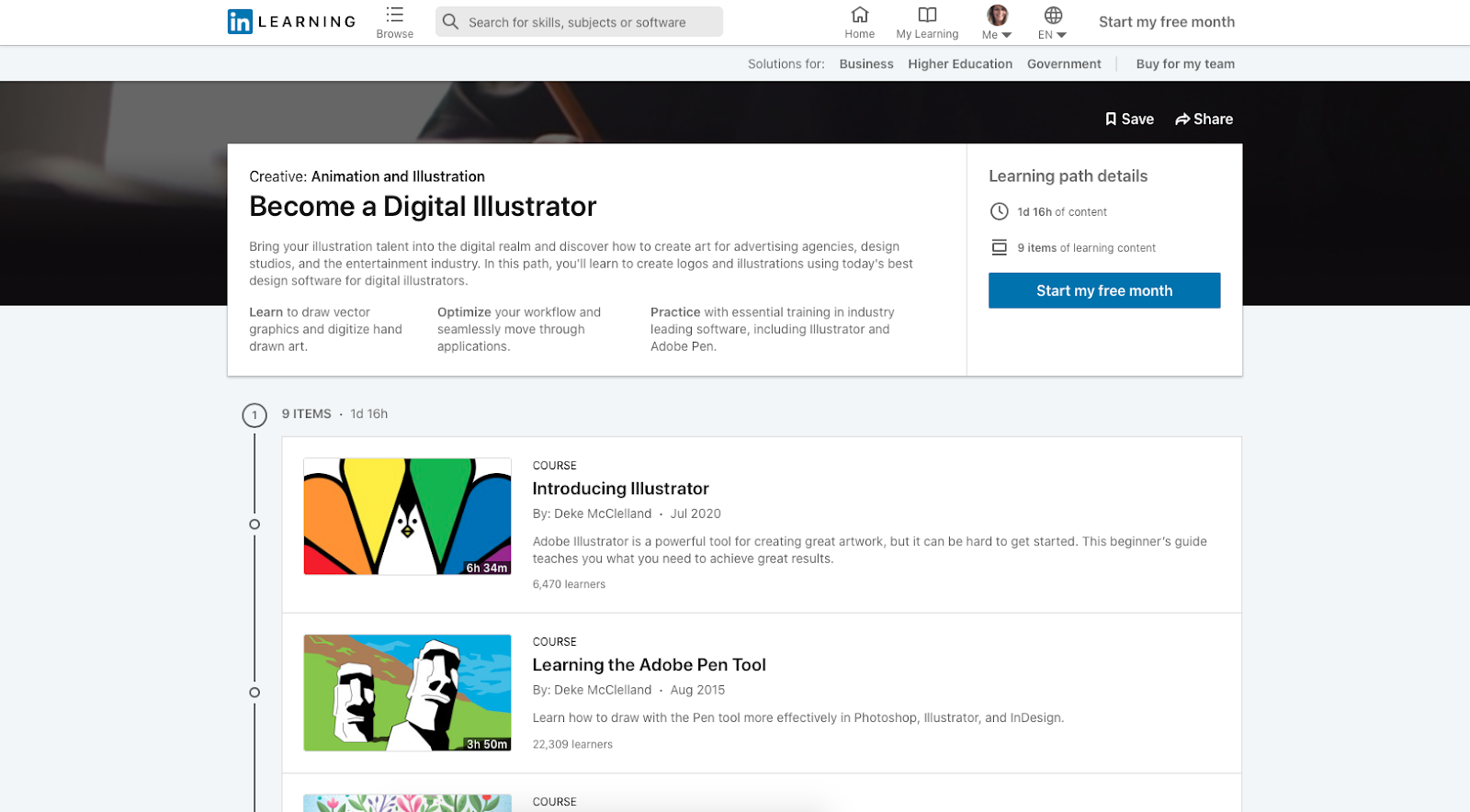What is an illustrator (and how do I become one)?

Have you ever thought about becoming an illustrator?
Maybe you saw an eye-catching cover on a science fiction book and wondered if you could create something like that. Maybe you’ve thought about it while reading a children's book to your kids. Or maybe you’re just starting to think about it because you saw the headline of this guide.
Whatever sparked your interest, becoming an illustrator is possible—and for a person with artistic talents, it can be a great way to earn a living as a freelancer, enabling you to build a fulfilling and profitable career making art.
Here’s how you can make it happen.
What is an illustrator?
The details vary, but in the broadest sense, illustrators help bring ideas to life. Illustrators are artists and they’re hired by a wide range of companies and industries to help turn ideas, concepts, and stories into clear, beautiful images.
While an illustrator may work for all kinds of businesses or even the government, the majority of illustrators work as freelancers—working on a project-by-project basis with multiple companies at any given time.
The exception to that rule often happens in the publishing or advertising agency spheres, where illustrating needs are large and frequent. Employers in those industries are more likely to bring a person full-time to be their in-house illustrator.
Illustrating vs. graphic design: What’s the difference?
Traditionally, illustrations were done by hand, often using pencils or paint. Some artists still work that way today, but many have moved onto the computer, using graphic design software like the kind built by Adobe.
That shift begs the question: What’s the difference between an illustrator and a graphic designer?
While an illustrator may use some of the same software as a graphic designer these days, there’s still a big difference between the role they each play when it comes to the projects they work on and the core purpose companies hire them for.
Here’s how Freepik explains the distinction between a graphic designer and an illustrator:
Illustration sits more in the realm of art than of design. An illustration is a visual that tells a story, that gives the viewer a pictorial representation of something. Even though both graphic designers and illustrators study the same basics of color and balance, the intent is different.
A graphic designer will often work on projects like brand logos, website design, magazine layouts, and product packaging. They use visual elements to get viewers to do something, whereas an illustrator creates visuals to help viewers understand or imagine something.
Common industries and projects for freelance illustrators
Illustrations are used across a huge variety of businesses and industries—that’s a big part of why becoming a freelance illustrator is such a flexible and profitable career path. While not exhaustive, here’s a look at some of the industries that use illustrators and artists quite frequently, along with common projects an illustrator might take on in each.
- Editorial: From magazines to newspapers to academic journals, all kinds of editorial organizations need help highlighting key points in their articles, visualizing complex ideas for readers, and fostering an emotional connection to the text.
- Product design: Artists help visualize product ideas during the initial development phase. They also draw up detailed illustrations of an existing product and its features to accompany product directions, sales and marketing collateral, and product packaging.
- Advertising agencies: From building storyboards for video ads to creating product images and illustrations to accompany text content, there’s a huge market for illustrators and artists in the advertising world.
- Greeting cards: A freelance illustrator may draw visuals to accompany pre-written text.
- Fashion design: Artists illustrating in the fashion industry create illustrations (usually drawings or paintings) of apparel and other fashion items that are used in fashion editorials, while selling products to buyers, and in fashion ads.
- Publishing: Perhaps the most visible industry, publishing illustrators and artists may create visuals for children’s books, draw up conceptual storyboards, design book covers and jackets, and even illustrate comic books and graphic novels.
- Technical: Technical illustrators turn technical information into visual representations that help make sense of intangible concepts. They might illustrate a software company’s onboarding manual, for example, or draw up the inner workings of a car’s engine.
- Medical: There’s a lot of demand for medical illustrators because they often require specialized medical knowledge of their own. Freelancers in this industry may illustrate human anatomy textbooks or create diagrams of medical devices, for example.
As you can see, there are a lot of opportunities for illustrators across a broad spectrum of industries and products—and there’s a lot of overlap between them, too. So no matter where your other interests lie, you can build your career as an illustrator around them.
How much do illustrators make?
Ah, the million dollar question. While a million dollars isn’t the most common annual income, you can make a comfortable living as a freelance illustrator.
Beyond that, there isn’t a concrete number you can hang your hat on. Hourly rates and annual salaries and project prices for illustrators represent a wide range—largely because there are a lot of factors that can impact your earnings.
- Do you price hourly or by project?
- Do companies hire you on retainer?
- Are you earning royalties on your work?
- What industry are you working in?
- What kind of illustrations are you creating?
- How much work do you do?
With all that in mind, we’ll look at some industry averages to help you get a better sense of how much you can earn as a freelance illustrator.
ZipRecruiter found illustrators earn $59,837 per year.
Let’s break that down and look at what a few other sources have to say to further hone our estimates.
When it comes to average annual salaries:
- Indeed reports $48,737 per year for freelance illustrators
- Glassdoor estimates $46,786 per year
Keep in mind: as you gain more experience and your portfolio of work grows, you can command higher and higher rates and push your earnings closer to the top end of the industry.
When it comes to hourly rates:
- ZipRecruiter found the average to be $29 per hour
- Indeed puts their estimate quite a bit higher at $45.61 per hour
As for project-based rates, Format lays out several real clients, along with what they pay for different types of illustrator projects. Here are a few highlights:
- Editorial illustrations for BuzzFeed: $350
- Book cover for HarperCollins: $3,000
- Children’s book for self-publishing author: $5,000+
- Cover illustration for Archie comics: $450
Who should become an illustrator?
In short: Any person who wants to turn their artistic skills into profitable work can become an illustrator.
There are several requirements you may find on an illustrator job description, but nearly all of them can be learned and developed at any age. Plus, the industry is much more about what you can do than any arbitrary bachelor's degree or education level.
So just about anyone with the drive can become an illustrator, whether you have a degree or not.
Now, let’s talk about those requirements.
Requirements: what skills are needed to be a freelance illustrator?
The requirements and job description for an illustrator will vary depending on the industry you work in, the type of work you do, and the individual client. But here are some of the baseline traits you’ll need to have or develop:
- Drawing skills, sketching, and other artistry: Enough said.
- Creativity: As we’ve said above, an illustrator is an artist, so creative thinking and problem solving are a must.
- Visual storytelling: You’ll need a strong understanding of how to turn ideas and stories—sometimes complex ones—into clear, easily digestible visuals.
- Familiarity with digital art and graphic design software: With much of the industry moving to digital, it’s a good idea to develop some experience with the most common graphic design software, including Adobe Creative Suite (Photoshop, Illustrator, InDesign) and more niche-specific software like computer-aided design (or CAD software).
- Niche-specific knowledge: Depending on the industry you choose to work in, you may need specific insider knowledge. That may include medical or technical knowledge or CAD familiarity.
- Detail-oriented: Illustrators often have to wrangle with extensive project briefs and detailed requirements from art directors, so strong attention to detail is key to keeping clients happy with your work.
- Communication: As a freelancer, you’re a business owner, not just an artist—and that means you need strong communication to sell yourself, set expectations with clients, and more.
- Business proficiency: Speaking of which, a successful freelance artist in any field needs to be unfailingly reliable, deadline-driven, self-motivated, and adaptable to change.
If you don’t feel like you can tick off all of the above, don’t worry. Illustration and freelancing of every stripe are all about constant learning and growth—you can develop what you need with practice as you grow more confident as a freelance illustrator and with focused learning.
Resources to become an illustrator
Did someone say ‘learning’?
One of the best things about becoming a freelance illustrator today is that there’s a massive amount of resources available to help you along the way.
Whether you’re looking to level up your drawing, learn a new illustration software, or become a more confident business owner, there are online courses and YouTube videos and how-to articles to help you along the way. And many of them are taught by experienced, successful illustrators and freelancers.
College courses for illustration
One option is to actually go to art school for illustration and complete a comprehensive fine arts degree program. While fine arts courses can be more expensive than other learning options, they can also offer a more well-rounded and curated learning program.
Here are a few colleges with renowned art school and illustration programs:
- SCAD (The Savannah College of Art & Design)
- RISD (Rhode Island School of Design)
- Pratt Institute
Self-taught avenues to become an illustrator
If a structured degree program isn’t what you’re looking for, you can opt for the self-taught avenue. Self-teaching is a common choice since the illustration industry is much more about demonstration of your skill (i.e. your portfolio of work) than it is about traditional education or fine arts degrees.
In other words: you can absolutely become an illustrator without a formal college degree.
Here are a few quick tips to help:
- Learn from other illustrators online via classes (more on that next!), YouTube videos (we love Sinix Design’s channel), Instagram profiles, and other education content online.
- Hone and refine your artistry by drawing every day.
- Remember to develop know-how that'll serve you on the business side of freelancing.
Beyond that, our best advice is to just start—then develop your skills (and raise your rates!) as you go and accumulate experience.
Online classes for freelance illustrators
There are thousands and thousands of online classes available for freelance illustrators to level up their skills. Whether you want a comprehensive course on the basics of illustration, a detailed how-to on using InDesign, or a tutorial on making money as an artist, there’s an online class (or several) that can help.
Here are some of the top websites for illustration classes, along with a few of your favorite online courses offered through each.
Skillshare classes

Skillshare’s video-based online courses are dedicated to all things creativity, including a wealth of illustration-focused classes.
Our top class picks:
- The Style Class: Work Out Your Illustration Style in a Daily Project
- Mastering Illustration: Sketching, Inking & Color Essentials
- Transition Into Illustration: Breaking Into the Industry
CreativeLive classes

Creative Live is an online learning hub designed for creatives, with classes taught by real, expert illustrators.
Our top class picks:
- Becoming a Working Artist
- Drawing the Everyday Every Day
- Make Things Make Money: The Business of Illustration
Udemy courses

Udemy is a massive online learning platform with classes spanning just about any topic you could ever want to learn about, including a specific hub for illustrators.
Our top class picks:
- The Complete Drawing & Painting Illustration Course
- Adobe Illustrator CC for Beginners
- Find Your Digital Illustration Style
LinkedIn Learning

LinkedIn Learning includes a variety of career-focused courses and curated ‘learning paths’ that string together multiple courses into a broader, comprehensive program.
Our top picks:
Becoming a freelance illustrator
No matter your background or degree, if you love to create art and tell stories through images and design, you can become a freelance illustrator.
By building up portfolios full of your artwork and committing to learning the role of Freelance Business Owner, you can turn art into a lucrative career path.













